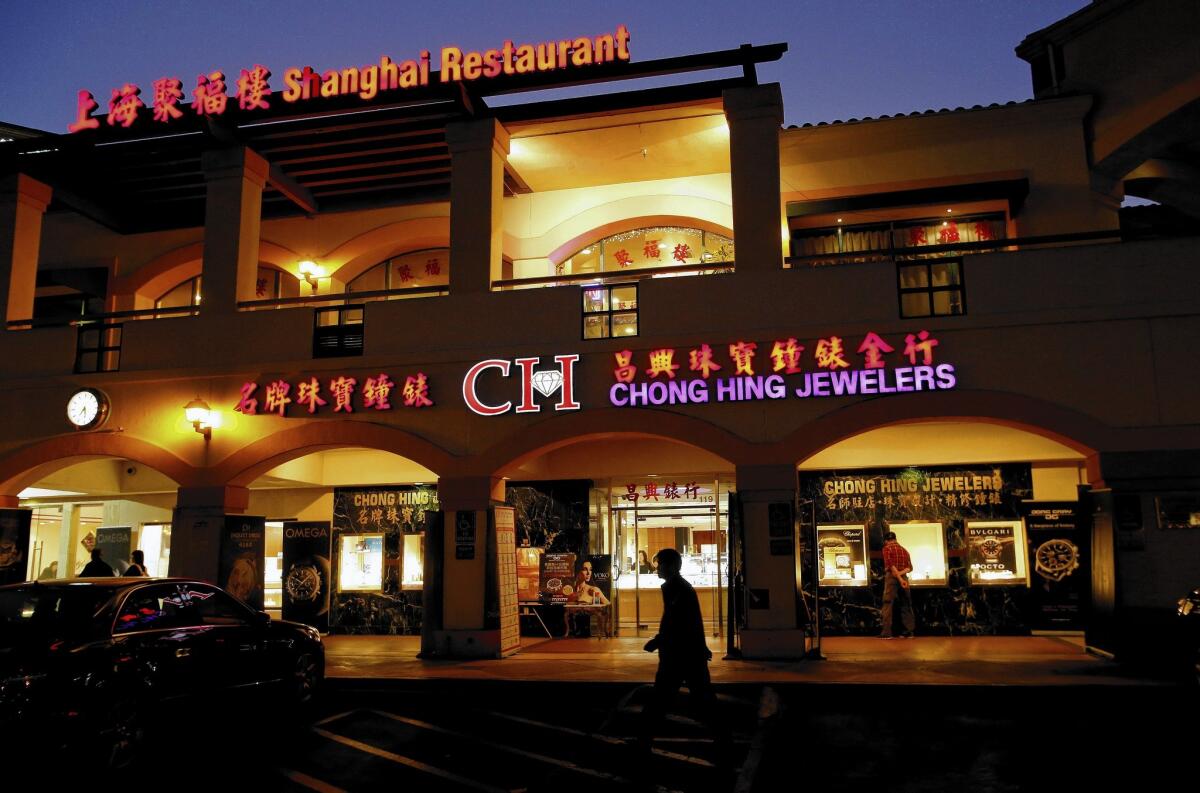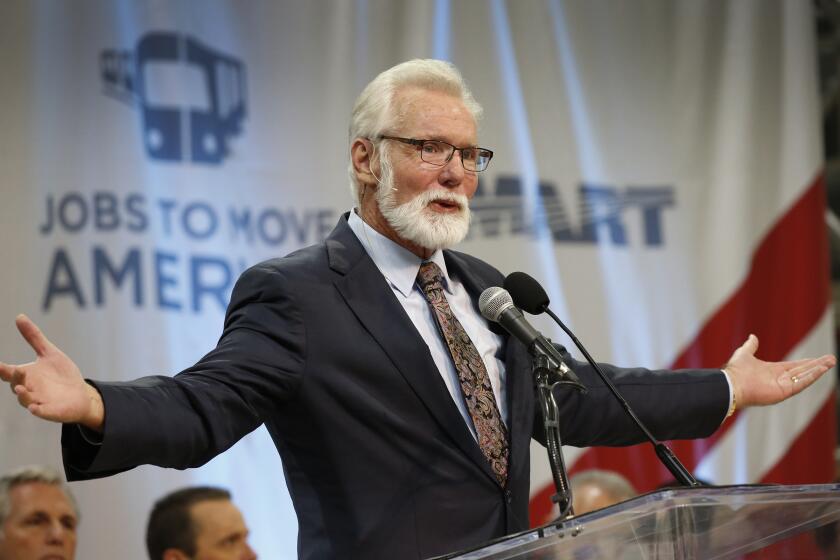Chinese visitors turning San Gabriel into a boomtown

- Share via
Chen Si, 35, and her husband visited Los Angeles from Shanghai for the first time in December, excited about local attractions like Disneyland and Hollywood.
They were less enthused about the idea of American food. They booked a room in San Gabriel, where friends said they could find “acceptable” Chinese food in the surrounding neighborhood, Si said.
The once-quiet suburb about 12 miles east of downtown Los Angeles is in the midst of a transformation built on the growing international reputation of its Chinese food and services.
FOR THE RECORD:
San Gabriel tourism: In the Feb. 13 Section A, an article about development and tourism on Valley Boulevard in San Gabriel misstated the location of two proposed hotels. Developer Sunny Chen has proposed a hotel at the site of a closed Norm’s restaurant near the intersection of Valley Boulevard and Del Mar Avenue, not the property next to it, which contains a closed furniture store. The Crowne Plaza hotel is slated for a property a block east from the site of the old Norm’s restaurant, not the restaurant site itself. —
These are boom times for Chinese tourism, and statistics show that about a third of those who travel to the United States spend at least some time in Los Angeles. But some are shunning coastal resorts and Beverly Hills opulence in favor of San Gabriel, a city of 40,000 best known for its historic mission.
“San Gabriel is famous in China,” said David Lee, chief executive of Hing Wa Lee Group, which recently opened a flagship jewelry store in San Gabriel a few hundred feet from a Hilton hotel, where many Chinese tourists stay. “It has become a brand name destination.”
The tourism boom has helped spark new development. A 316-room Crowne Plaza Hotel is slated to open next door to the Hilton in 2015, taking over an overgrown lot that once housed a Norm’s restaurant. Hilton developer Sunny Chen is applying to build another hotel right next to that at the site of an old furniture store.
With no beaches, no major landmarks and few A-list shops or restaurants, San Gabriel is an unlikely tourist destination. But the city has a Chinese-style five-star hotel within walking distance of a thriving community of Chinese restaurants, Asian banks and multilingual travel agencies. Visitors to San Gabriel sometimes use the city as a home base for trips throughout the Southland, returning to Valley Boulevard to eat.
“No matter where Chinese people go, no matter where they are from, they cannot change their appetite,” said Steve Chiang, a Chinese newspaper publisher and president of the Rosemead Chamber of Commerce.
On a recent weekday, a driving drumbeat off Valley Boulevard signaled the opening of a new business.
A Monterey Park lion dance troupe performed on a sidewalk bristling with cameras and reporters from the Chinese language media, kicking off the opening reception for Lee’s largest jewelry store. It’s a softly lighted domed building with Swiss architectural flourishes, located on a small parcel carved from the parking lot of the 99 Ranch grocery store.
Inside, a guest list of politicians and luxury watch brand presidents sat down to a 10-course meal at tables set with gold cloths, napkins and chair ribbons. Lang Lang, a Chinese pianist who recently performed with Metallica at the Grammys, provided the entertainment from an elevated grand piano.
Lee says he’s trying to cater to Chinese nationals, who form about 70% of his business. Chinese travelers spend about $3,000 on each trip to California, more than visitors from any other nation, according to data from the U.S. Office of Travel and Tourism Industries. Here they find cheaper prices for name brand products like watches and iPhones, and it’s more likely that they’ll be genuine in America, Lee said.
San Gabriel’s “name recognition has become luxury,” said Julie Tang, general manager of Park Place International, a San Gabriel travel agency. “And it has become so Chinese. That’s the reason it’s been successful.”
When waves of Chinese immigrants settled in the San Gabriel Valley in the 1980s, Monterey Park was declared the first suburban Chinatown. But the epicenter of the community has been moving east ever since. The San Gabriel Square, a 219,000-square-foot retail development known colloquially as the Great Mall of China, has drawn huge numbers of Chinese from throughout the Southland since the 1990s. The Hilton’s arrival on Valley Boulevard in 2004 funneled a stream of wealthy Chinese nationals to San Gabriel, and luxury businesses followed.
Now it’s almost impossible to get a room at the Hilton, which is about 90% occupied year-round. On this section of Valley Boulevard, the familiar $15 foot massage is giving way to $100 muscle treatments and billboards advertising $12,000 watches. Nearly 100 restaurants, 36 jewelry stores, 20 travel and tour bus businesses and 12 banks are crammed into a series of two-story strip malls.
In the mornings, cars jostle with dozens of tour buses ferrying visitors to casinos, Disneyland and other local attractions. Long lines form at Chinese restaurants and grocery stores in the evenings.
It’s a lifestyle that is appealing to an increasing number of Chinese nationals, who worry about the environmental and economic future of their country. According to the Hurun Report, a publication chronicling Chinese wealth, more than 60% of Chinese millionaires are considering emigration, with the U.S. as a primary destination.
Ta, a guest at the San Gabriel Hilton who wished to be known only by her last name, is visiting the U.S. from China for the first time. She and her husband have started to look around for homes.
“Our friends are talking about it,” said Ta, hitching a gold-zippered red Prada bag further up on her shoulder and snapping a picture of a her daughter with an iPhone.
Ta, who spoke no English, was full of questions about life in America. Which cities were best for Chinese people to live in? What about the schools in Arcadia and San Marino? How were the colleges?
Valley Boulevard caters to these families as well. As you exit the San Gabriel Hilton, a glass-walled office to the left advertises a new home loan program for foreign nationals. In the office on the right, Victor Chang, an immigration attorney, helps Chinese investors get visas and green cards.
His company, California Investment Immigration Fund, helps Chinese investors navigate a special immigration program that awards visas in exchange for investments of $500,000 or more. Chang says he currently manages more than 150 clients looking to obtain these investor visas, and walk-up business from Hilton guests is common.
Tourism, and the investment it helps generate, helped shield San Gabriel from the 2008 recession. The total value of all commercial and residential real estate within the city has doubled in the last decade, bucking countywide trends, according to city records. And the San Gabriel Square strip mall can generate more sales tax revenue than some of the city’s commercial corridors, according to city officials.
But not everyone is pleased with Valley Boulevard’s increasing prominence.
Road maintenance costs are on the rise along the heavily trafficked thoroughfare, and residents say rush hour is miserable. The city is considering ordinances that would calm traffic and limit the number of buses picking up people on the street.
And a persistent complaint is having to drive out of the city to shop at a Western market like Ralph’s or Vons.
“We have longtime residents that feel the city is giving in to a certain culture,” said Mary Cammarano, a former city councilwoman.
But Cammarano says nearly everyone understands that the tourism is “extremely valuable.” More hotels could mean millions of dollars more in transit occupancy tax revenue for the city to repair roads and spur economic growth.
And developers competing for Chinese luxury tourism dollars are trying something new: adopting Western culture.
In the lobby of the proposed Crowne Plaza hotel, the anchor restaurant will be Smitty’s Grill, which also has a location in Pasadena that serves American comfort food.
More to Read
Sign up for Essential California
The most important California stories and recommendations in your inbox every morning.
You may occasionally receive promotional content from the Los Angeles Times.











